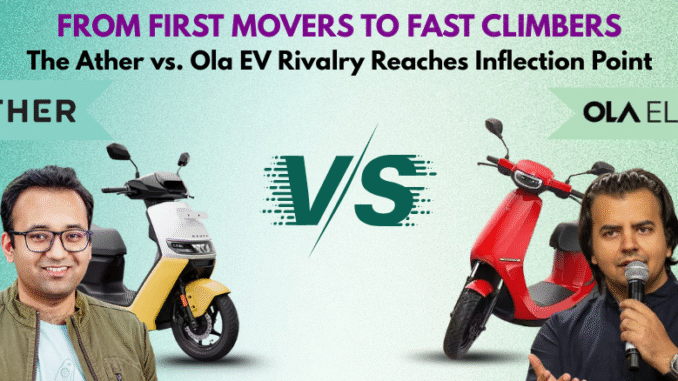
What happens when the methodical engineer meets the aggressive aggregator in India’s electric mobility arena? The answer arrived not with fanfare or dramatic announcements, but through a quiet reversal in monthly registration data that redefined the competitive landscape. Ather Energy and Ola Electric—representing fundamentally opposing philosophies on how to electrify India’s two-wheeler future—reached their defining moment when quality-obsessed patience finally overtook blitzscaling ambition in a market projected to reach $23.52 billion by 2030.
The September 2025 Market Revolution
According to verified Vahan portal data, the competitive landscape was dramatically reshuffled in September 2025. While legacy players TVS Motor retained the top position with 21,052-22,481 registrations (21.6% market share) and Bajaj Auto secured second place with 17,972-19,519 units (18.8% share), the real story was Ather Energy’s climb to third position with 16,558-18,109 registrations (17.4% share), pushing the former leader Ola Electric down to fourth place with just 12,223-13,371 units (12.9% share).
This represents a stunning reversal of fortune. Ola Electric’s registrations plummeted nearly 30-35% month-on-month, occurring despite aggressive discount campaigns, while Ather demonstrated consistent upward momentum driven by strategic product innovation and market expansion.
The Strategic DNA: Two Fundamentally Different Approaches
Ather Energy, founded in 2013 by IIT Madras alumni Tarun Mehta and Swapnil Jain, represented the engine er’s approach—methodical, quality-obsessed, and ecosystem-focused. Their strategy prioritized deep R&D investment, premium positioning, and building the Ather Grid charging infrastructure before achieving scale.
Ola Electric, launched in 2017 as a subsidiary of Ola Cabs by Bhavish Aggarwal, embodied the aggregator’s philosophy—blitzscaling through massive manufacturing investments, aggressive pricing, and direct-to-consumer sales models bypassing traditional dealerships entirely.
The Rizta Revolution: Ather’s Game-Changing Strategy
Ather’s September success stems primarily from the April 2024 launch of the family-oriented Ather Rizta, which now accounts for approximately 70% of the company’s total sales. This strategic pivot from performance-focused urbanites to family mobility broadened Ather’s addressable market significantly. The Rizta crossed 1 lakh unit retail sales by June 2025, demonstrating exceptional market acceptance.
Simultaneously, Ather executed strategic geographic expansion, with retail touchpoints growing 156% year-on-year as the company penetrated non-South markets including Gujarat and Maharashtra. Combined with their reputation for quality and the industry’s most extensive fast-charging network, this created a powerful competitive advantage.
Ola’s Service Crisis: When Scale Meets Reality
Ola Electric’s decline reflects deeper structural challenges beyond product performance. While their scooters offer competitive features, range, and pricing, the ownership experience has been severely compromised by widespread quality issues and, most critically, a dysfunctional after-sales service network.
Customer complaints detail everything from software glitches and sudden shutdowns to poor build quality and braking system flaws. More damaging, service centers are described as “graveyards” with hundreds of scooters awaiting repairs for weeks. This service collapse has eroded consumer trust despite Ola’s technological capabilities and manufacturing scale.
The company’s history includes a voluntary recall of 1,441 scooters in 2022 following fire incidents, further contributing to consumer safety concerns and brand reputation challenges.
Year-to-Date Reality Check
While Ather won the September battle, the broader war remains contested. In year-to-date sales (January-September 2025), Ola Electric maintains leadership with approximately 1.5-1.6 lakh units sold, compared to Ather’s 1.3 lakh units. However, the gap is rapidly narrowing, and momentum has clearly shifted toward Ather’s methodical, quality-focused approach.
Market Maturation: Beyond Price to Performance
September 2025’s results suggest India’s electric two-wheeler market is evolving beyond early-adopter dynamics. As the segment matures, consumers increasingly prioritize reliability, service quality, and long-term ownership experience over aggressive pricing alone.
Ather Energy’s success validates the hypothesis that sustainable competitive advantage in automotive markets requires industrial discipline, customer-centricity, and operational excellence—not just technological innovation or manufacturing scale.
Ola Electric’s challenges demonstrate that in the automotive industry, selling vehicles represents only the beginning. Supporting them through their operational lifecycle builds lasting customer trust and market leadership.
The ultimate victor will be determined not by who moved first or scaled fastest, but by who can successfully merge innovation with industrial discipline, quality with accessibility, and ambition with execution excellence in India’s rapidly electrifying mobility landscape.



